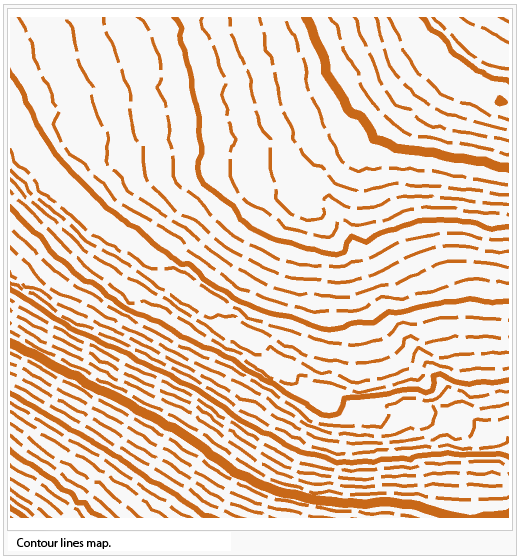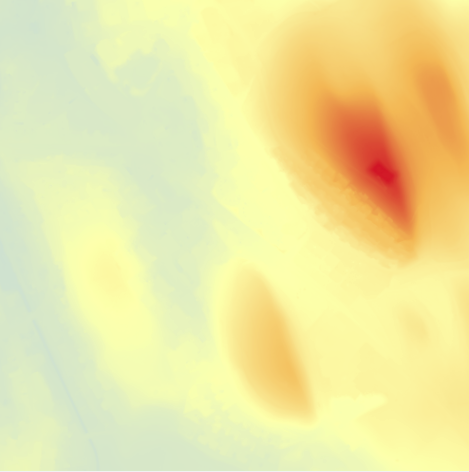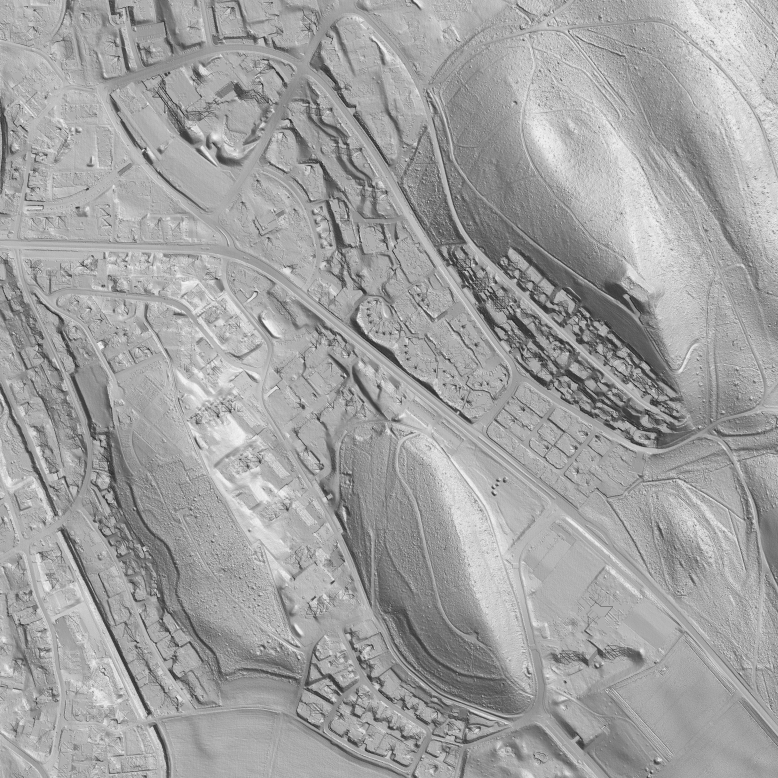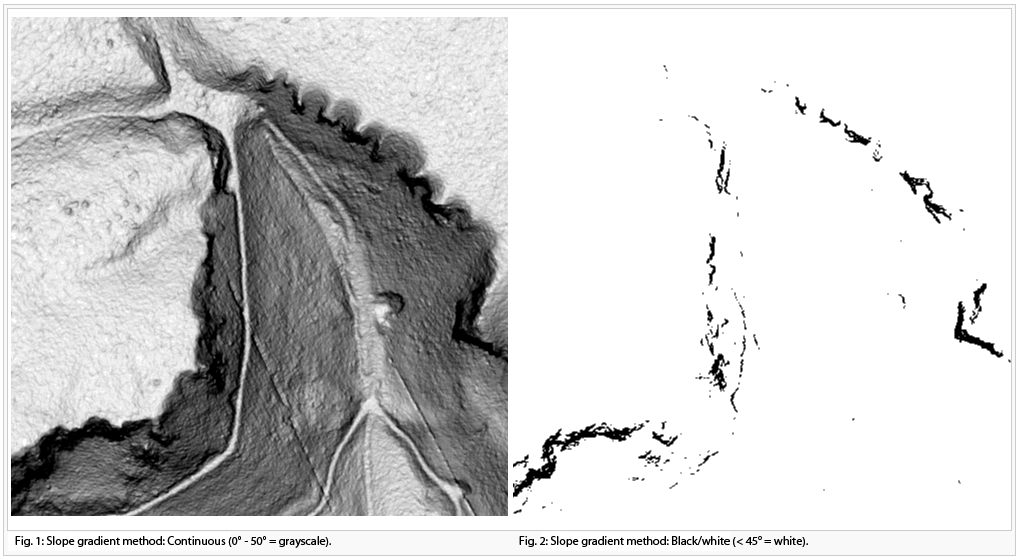DEM: Difference between revisions
m (→Import) |
No edit summary |
||
| Line 1: | Line 1: | ||
A DEM (Digital Elevation Model) contains points with elevation data. Data | A DEM (Digital Elevation Model) contains points with elevation data. DEM Data are based on LIDAR (Light Detection and Ranging) technology measurement, also known as Airborne Laser Scanning. There are DEM with point data arranged in a regular grid with a constant distance between the points. This distance is called cell size. Other DEM contain data points arranged irregularly (cloud-model). | ||
: Read more about this topic: http://en.wikipedia.org/wiki/Digital_elevation_model | : Read more about this topic: http://en.wikipedia.org/wiki/Digital_elevation_model | ||
| Line 6: | Line 6: | ||
==Import== | ==Import== | ||
OCAD DEM Module is able to import regular and irregular DEM data | The OCAD DEM Module is able to import files with regular and irregular DEM data. Supported DEM dataformats are: ESRI ASCII Grid and xyz file. Binary files are not supported. | ||
# Open a new map in the '''File''' menu and select scale and symbols for your basemap. | |||
# '''Import''' a Raw data ASCII XYZ file, an ASCII Grid XYZ file, a SRTM file (*.hgt), a LAS file or an ESRI ASCII Grid file to OCAD. First use '''Add''' button to add a DEM to the '''DEM Import''' dialog. | # Select the DEM menu and '''Import''' a Raw data ASCII XYZ file, an ASCII Grid XYZ file (*.xyz), a SRTM file (*.hgt), a LAS file (*.las) or an ESRI ASCII Grid file (*.asc) to OCAD. First use '''Add''' button to add a DEM to the '''DEM Import''' dialog. | ||
# | # Select '''Analyze''' the DEM to get some information about the DEM like extent, cell size etc. | ||
# If the source file is a regular grid (Data type of import files = Grid), the '''Cell size''' box is set to read only. OCAD sets the same cell size for the imported DEM. For irregular source DEM (Data type of import files = Raw) the cell size can be set in the cell size box. For these DEM OCAD interpolates a regular grid with the specified cell size during the import. | # If the source file is a regular grid (Data type of import files = Grid), the '''Cell size''' box is set to read only. OCAD sets the same cell size for the imported DEM. For irregular source DEM data (Data type of import files = Raw) the cell size can be set in the 'cell size' box. For these DEM OCAD interpolates a regular grid with the specified cell size during the import. | ||
# At the end of the import procedure the imported DEM must be saved in OCAD DEM file format (*.ocdDem) and it is loaded to the OCAD map. | # At the end of the import procedure the imported DEM must be saved in OCAD DEM file format (*.ocdDem) and it is loaded to the OCAD map. | ||
# To see the extent of the loaded DEM | # To see the extent of the loaded DEM activate the '''Show Frame''' menu item. | ||
: [[File:Hint.jpg|hint]] The '''Cell size''' has to be an integer value. The minimum | : [[File:Hint.jpg|hint]] The '''Cell size''' has to be an integer value. The minimum cell size is 1m. | ||
: [[File:Hint.jpg]] DEM import is limited to approximately 25 mio. data points resp. 20 mio. data points for LAS files. | : [[File:Hint.jpg]] DEM import is limited to approximately 25 mio. data points, resp. 20 mio. data points for LAS files. | ||
'''In Summary, for example import LAS data:''' | '''In Summary, for example import of LAS data:''' | ||
: [[File:DEMImport.PNG]] | : [[File:DEMImport.PNG]] | ||
# Choose '''Import''' from '''DEM''' menu. The dialog box '''DEM Import''' appears. | # Choose '''Import''' from '''DEM''' menu. The dialog box '''DEM Import''' appears. | ||
# '''Add''' a DEM. | # '''Add''' a DEM data file. | ||
# '''Analyze''' the DEM and click '''Save'''. | # '''Analyze''' the DEM and click '''Save'''. | ||
| Line 41: | Line 41: | ||
==Show Frame== | ==Show Frame== | ||
Shows blue rectangle with the extent of loaded DEM. | Shows blue rectangle with the extent of the loaded DEM. | ||
| Line 64: | Line 64: | ||
To merge two different | To merge two different DEM, choose '''Merge''' from '''DEM''' menu. | ||
| Line 71: | Line 71: | ||
:[[File:Hint.jpg]] The two DEMs must have the same cell size and image clipping. | :[[File:Hint.jpg]] The two DEMs must have the same data format, cell size and image clipping. | ||
==Calculate DEM Difference== | ==Calculate DEM Difference== | ||
| Line 79: | Line 79: | ||
# Choose '''Calculate DEM Difference''' from '''DEM''' menu. | # Choose '''Calculate DEM Difference''' from '''DEM''' menu. | ||
# The '''Calculate DEM Difference''' dialog box appears. | # The '''Calculate DEM Difference''' dialog box appears. | ||
# Add ''Upper DEM'' = DSM | # Add ''Upper DEM'' = DSM data file | ||
# Add ''Lower DEM'' = DEM | # Add ''Lower DEM'' = DEM data file | ||
# Click '''OK'''. | # Click '''OK'''. | ||
| Line 91: | Line 91: | ||
: [[File:Hint.jpg]] Same cell size and clipping of DSM and DEM. | : [[File:Hint.jpg]] Same data format, cell size and clipping of DSM and DEM. | ||
==Create Contour Lines== | ==Create Contour Lines== | ||
| Line 98: | Line 98: | ||
:This function calculates contour lines based on the loaded DEM. | :This function calculates contour lines based on the loaded DEM. | ||
:1-3 contour intervals (for example 1m, 5m, 25m) and a symbol for each can be | :1-3 contour intervals (for example 1m, 5m, 25m) and a pre-selected line symbol (according to the first three line symbols in the settings) for each type appears (can be changed). | ||
:Specify the minimum and maximum contour for the calculation. | :Specify the minimum (lowest) and maximum (highest)contour for the calculation. | ||
[[File:ContourLines.PNG]] | [[File:ContourLines.PNG]] | ||
| Line 112: | Line 112: | ||
Two different types of hypsometric maps can be edited: | |||
* Grayscale hypsometric map | * Grayscale hypsometric map | ||
| Line 131: | Line 131: | ||
: | :Aside from the chosen method an '''Azimuth''' and a '''Declination''' of the light source has to be set. Standard settings are 315° (north-west) and 45°. An '''Exaggeration''' factor of 4 is pre-selected and can be altered. | ||
[[File:HillShading.PNG]] | [[File:HillShading.PNG]] | ||
| Line 144: | Line 144: | ||
Select one of two different methods: | |||
* Continous (<x° = grayscale / >x° = black) | * Continous (<x° = grayscale / >x° = black) | ||
| Line 159: | Line 159: | ||
There are two different options to | There are two different options to show vegetation height classification: | ||
* gray scale classification | * gray scale classification | ||
* | * Color classification | ||
[[File:VegetationHeight.PNG]] | [[File:VegetationHeight.PNG]] | ||
Legend for | Legend for color classification: | ||
: Meter statement refers to the difference between the two DEMs. | : Meter statement refers to the difference between the two DEMs. | ||
: [[File:Legend_VegetationHeight.PNG]] | : [[File:Legend_VegetationHeight.PNG]] | ||
| Line 172: | Line 172: | ||
==Create Profile== | ==Create Profile== | ||
: Create Profile command is only activated if 1 line object in the map is selected. The command calculates a profile for the selected line object. | : Create Profile command is only activated if 1 line object in the map is selected. The command calculates a profile for the selected line object. | ||
: In the '''DEM Profile''' dialog box choose between '''Auto scale''' option and a manually set '''Scale'''. Turn on/off | : In the '''DEM Profile''' dialog box choose between '''Auto scale''' option and a manually set '''Scale'''. Turn on/off '''Grid'''. | ||
: The '''Elevation factor''' is | : The '''Elevation factor''' is the scale factor between the vertical and horizontal profile axis. The '''Elevation resolution''' and the '''Length resolution''' are filters that influence the calculation of the total ascent and total descent. These resolution values should not be more accurate than the elevation resolution and cell size of the DEM. | ||
: It is possible to '''Add the profile to the actual OCAD map''', to '''Export''' it as *.ocd, *.bmp or *.gif file or to Print it. | : It is possible to '''Add the profile to the actual OCAD map''', to '''Export''' it as *.ocd, *.bmp or *.gif file or to Print it. | ||
: [[File:Hint.jpg|hint]] '''DEM Profile''' dialog is a non-modal dialog. The user can switch between it and OCAD map window. It is possible to edit the selected line object in the OCAD map. Click '''Update''' button in the '''DEM Profile''' dialog to see the profile for the edited object. | : [[File:Hint.jpg|hint]] '''DEM Profile''' dialog is a non-modal dialog. The user can switch between it and the OCAD map window. It is possible to edit the selected line object in the OCAD map. Click the '''Update''' button in the '''DEM Profile''' dialog to see the profile for the edited object. | ||
==Export== | ==Export== | ||
| Line 186: | Line 186: | ||
Export OCAD DEM file as ESRI ASCII Grid or as ASCII Grid XYZ. | Export OCAD DEM file as ESRI ASCII Grid or as ASCII Grid XYZ. | ||
Select '''Create tiles''' for large DEMs. | |||
Previous Chapter: [[Printing Maps]] | Previous Chapter: [[Printing Maps]] | ||
Revision as of 18:23, 2 February 2012
A DEM (Digital Elevation Model) contains points with elevation data. DEM Data are based on LIDAR (Light Detection and Ranging) technology measurement, also known as Airborne Laser Scanning. There are DEM with point data arranged in a regular grid with a constant distance between the points. This distance is called cell size. Other DEM contain data points arranged irregularly (cloud-model).
- Read more about this topic: http://en.wikipedia.org/wiki/Digital_elevation_model
Import
The OCAD DEM Module is able to import files with regular and irregular DEM data. Supported DEM dataformats are: ESRI ASCII Grid and xyz file. Binary files are not supported.
- Open a new map in the File menu and select scale and symbols for your basemap.
- Select the DEM menu and Import a Raw data ASCII XYZ file, an ASCII Grid XYZ file (*.xyz), a SRTM file (*.hgt), a LAS file (*.las) or an ESRI ASCII Grid file (*.asc) to OCAD. First use Add button to add a DEM to the DEM Import dialog.
- Select Analyze the DEM to get some information about the DEM like extent, cell size etc.
- If the source file is a regular grid (Data type of import files = Grid), the Cell size box is set to read only. OCAD sets the same cell size for the imported DEM. For irregular source DEM data (Data type of import files = Raw) the cell size can be set in the 'cell size' box. For these DEM OCAD interpolates a regular grid with the specified cell size during the import.
- At the end of the import procedure the imported DEM must be saved in OCAD DEM file format (*.ocdDem) and it is loaded to the OCAD map.
- To see the extent of the loaded DEM activate the Show Frame menu item.
 The Cell size has to be an integer value. The minimum cell size is 1m.
The Cell size has to be an integer value. The minimum cell size is 1m. DEM import is limited to approximately 25 mio. data points, resp. 20 mio. data points for LAS files.
DEM import is limited to approximately 25 mio. data points, resp. 20 mio. data points for LAS files.
In Summary, for example import of LAS data:
- Choose Import from DEM menu. The dialog box DEM Import appears.
- Add a DEM data file.
- Analyze the DEM and click Save.
- Save
- Open: Open an OCAD DEM file (*.ocdDem).
- Show Frame: Shows blue rectangle with the extent of loaded DEM.
- Resize:Resize OCAD DEM file (make a subset) and save it as a new OCAD DEM file.
- Info: Shows information about OCAD DEM file.
- Close: Close OCAD DEM file.
Open
Open an OCAD DEM file (*ocdDem).
Show Frame
Shows blue rectangle with the extent of the loaded DEM.
Resize
Resize OCAD DEM file (make a subset) and save it as a new OCAD DEM file.
Info
Shows information about OCAD DEM file.
Close
Close OCAD DEM file.
Merge DEM
To merge two different DEM, choose Merge from DEM menu.
- DEM 1: Choose the first DEM.
- DEM 2: Choose the second DEM.
Calculate DEM Difference
- Choose Calculate DEM Difference from DEM menu.
- The Calculate DEM Difference dialog box appears.
- Add Upper DEM = DSM data file
- Add Lower DEM = DEM data file
- Click OK.
To see the DEM difference choose [Classify Vegetation Height]
- No difference between the elevation models appears black.
- The greater the difference, the whiter it appears.
Create Contour Lines
- This function calculates contour lines based on the loaded DEM.
- 1-3 contour intervals (for example 1m, 5m, 25m) and a pre-selected line symbol (according to the first three line symbols in the settings) for each type appears (can be changed).
- Specify the minimum (lowest) and maximum (highest)contour for the calculation.
Create Hypsometric Map
- This function calculates a grayscale or colored hypsometric map as GeoTIFF file.
- Optionally it is directly loaded as background map.
Two different types of hypsometric maps can be edited:
- Grayscale hypsometric map
- Colored hypsometric map
Create Hill Shading
- This function calculates a shaded relief picture (hill shading).
- There are two calculation methods available:
- Slope shading is optimized to see outlines of features like paths in a slope.
- Slope shading combined with oblique light shading is the recommended method if the hill shading should be used as a background relief of a map. Optionally the calculated hill shading is directly loaded as background map.
- Aside from the chosen method an Azimuth and a Declination of the light source has to be set. Standard settings are 315° (north-west) and 45°. An Exaggeration factor of 4 is pre-selected and can be altered.
Calculate Slope Gradient
- Choose Calculate Slope Gradient from DEM menu.
- The Calculate Slope Gradient dialog box appears.
Select one of two different methods:
- Continous (<x° = grayscale / >x° = black)
- Black/White (<x° = white / >x° = black)
Classify Vegetation Height
Choose Classify Vegetation Height from DEM menu.
There are two different options to show vegetation height classification:
- gray scale classification
- Color classification
Legend for color classification:
Create Profile
- Create Profile command is only activated if 1 line object in the map is selected. The command calculates a profile for the selected line object.
- In the DEM Profile dialog box choose between Auto scale option and a manually set Scale. Turn on/off Grid.
- The Elevation factor is the scale factor between the vertical and horizontal profile axis. The Elevation resolution and the Length resolution are filters that influence the calculation of the total ascent and total descent. These resolution values should not be more accurate than the elevation resolution and cell size of the DEM.
- It is possible to Add the profile to the actual OCAD map, to Export it as *.ocd, *.bmp or *.gif file or to Print it.
 DEM Profile dialog is a non-modal dialog. The user can switch between it and the OCAD map window. It is possible to edit the selected line object in the OCAD map. Click the Update button in the DEM Profile dialog to see the profile for the edited object.
DEM Profile dialog is a non-modal dialog. The user can switch between it and the OCAD map window. It is possible to edit the selected line object in the OCAD map. Click the Update button in the DEM Profile dialog to see the profile for the edited object.
Export

|
Export OCAD DEM file as ESRI ASCII Grid or as ASCII Grid XYZ. Select Create tiles for large DEMs.
Previous Chapter: Printing Maps
Next Chapter: GPS
Back to Main Page











